Search Results for bite
Explore AI generated designs, images, art and prompts by top community artists and designers.

Create a funny meme-style scene inspired by a pop star michael Jackson with curly black hair and a light glossy lipstick , wearing a classic stylish outfit. He is standing inside a McDonald’s , looking at another man who is about to take his first bite of a big hamburger and fries. The pop star has a curious and playful expression , with his eyes focused on the burger , as if fascinated or tempted by it. Warm restaurant lighting , cinematic framing , slightly exaggerated expressions for comic effect. ,

A capsule-shaped pill lies in the middle of a dark. One half of the pill is transparent like glass. Inside , there is a small , cozy sofa. A Predator sitting in the sofa , like a child , traveling through a massive wormhole , inhabited by menfolk with iridescent scales floating in the air has a vine-made ladder extending through the clouds from the castle to the ground , where a peoples climbing together toward a shining , elusive doorway at the top. The background is a dreamy scene of endless mountains and trees of flowers. filling the entire dreamland with floating rainbow bridge and nebula tunnel. ,

A group of young men are sailing on a small white sailboat in the open ocean. The camera records in a raw , realistic handheld style , as if filmed on a phone by one of the passengers. Suddenly , a massive orca surfaces next to the boat and lunges toward them , opening its jaws wide as it tries to bite one of the men leaning over the edge. The men scream in shock , scrambling back as the camera shakes violently , capturing the orca’s sharp teeth , splashing water , and the terrified reactions on board. The sea is slightly rough , with waves rocking the boat under a cloudy sky. Recorded like an amateur sailing video , unpolished and realistic. ,

Surrounded by auspicious clouds , the city built within a giant , bioluminescent seashell , inhabited by merfolk with iridescent scales floating in the air has a vine-made ladder extending through the clouds from the palace to the ground , where a peoples climbing together toward a shining , elusive doorway at the top. The background is a dreamy scene of endless mountains and trees of flowers. filling the entire dreamland with floating rainbow bridge and nebula tunnel. ,
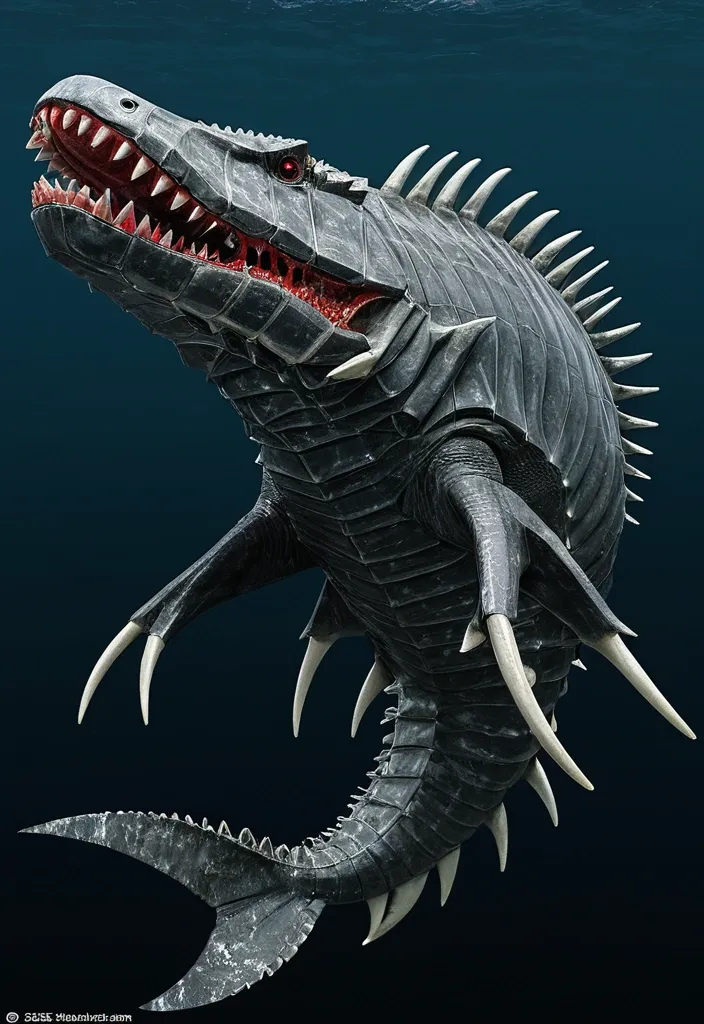
Female , Length: 40-60 feet , Weight: 50-75 tons , Lifespan: 100-135 years , Color is a slate gray base with white and red photophores arranged in tiger stripe patterns along the flanks and dorsal ridge , glowing vividly in abyssal darkness , a Robust , muscular frame combining the thick , armored scales of saltwater crocodile and arapaima with a hydrodynamic , flexible body of Mosasaurus Hoffmannii , Large , rigid pectoral fins capable of tilting backward to reduce drag , inspired by the Black Marlin’s speed adaptations , Powerful flippers adapted for both swimming and short-distance land movement , similar to a leopard seal’s scooting style , Enormous , reinforced jaws with over 40 , 000 PSI bite force , lined with long , razor-sharp canine teeth from Predator X and Megalodon genetics , Venomous spines inspired by the crown-of-thorns starfish line the dorsal ridge , delivering painful wounds to predators or rivals. ,

Female , Length: 40-60 feet , Weight: 50-75 tons , Lifespan: 100-135 years , Color is a slate gray base with white and red photophores arranged in tiger stripe patterns along the flanks and dorsal ridge , glowing vividly in abyssal darkness , a Robust , muscular frame combining the thick , armored scales of saltwater crocodile and arapaima with a hydrodynamic , flexible body of Mosasaurus Hoffmannii , Large , rigid pectoral fins capable of tilting backward to reduce drag , inspired by the Black Marlin’s speed adaptations , Powerful flippers adapted for both swimming and short-distance land movement , similar to a leopard seal’s scooting style , Enormous , reinforced jaws with over 40 , 000 PSI bite force , lined with long , razor-sharp canine teeth from Predator X and Megalodon genetics , Venomous spines inspired by the crown-of-thorns starfish line the dorsal ridge , delivering painful wounds to predators or rivals. ,

Female , Length: 40-60 feet , Weight: 50-75 tons , Lifespan: 100-135 years , Color is a slate gray base with white and red photophores arranged in tiger stripe patterns along the flanks and dorsal ridge , glowing vividly in abyssal darkness , a Robust , muscular frame combining the thick , armored scales of saltwater crocodile and arapaima with a hydrodynamic , flexible body of Mosasaurus Hoffmannii , Large , rigid pectoral fins capable of tilting backward to reduce drag , inspired by the Black Marlin’s speed adaptations , Powerful flippers adapted for both swimming and short-distance land movement , similar to a leopard seal’s scooting style , Enormous , reinforced jaws with over 40 , 000 PSI bite force , lined with long , razor-sharp canine teeth from Predator X and Megalodon genetics , Venomous spines inspired by the crown-of-thorns starfish line the dorsal ridge , delivering painful wounds to predators or rivals. ,

Female , Length: 40-60 feet , Weight: 50-75 tons , Lifespan: 100-135 years , Color is a slate gray base with white and red photophores arranged in tiger stripe patterns along the flanks and dorsal ridge , glowing vividly in abyssal darkness , a Robust , muscular frame combining the thick , armored scales of saltwater crocodile and arapaima with a hydrodynamic , flexible body of Mosasaurus Hoffmannii , Large , rigid pectoral fins capable of tilting backward to reduce drag , inspired by the Black Marlin’s speed adaptations , Powerful flippers adapted for both swimming and short-distance land movement , similar to a leopard seal’s scooting style , Enormous , reinforced jaws with over 40 , 000 PSI bite force , lined with long , razor-sharp canine teeth from Predator X and Megalodon genetics , Venomous spines inspired by the crown-of-thorns starfish line the dorsal ridge , delivering painful wounds to predators or rivals. ,
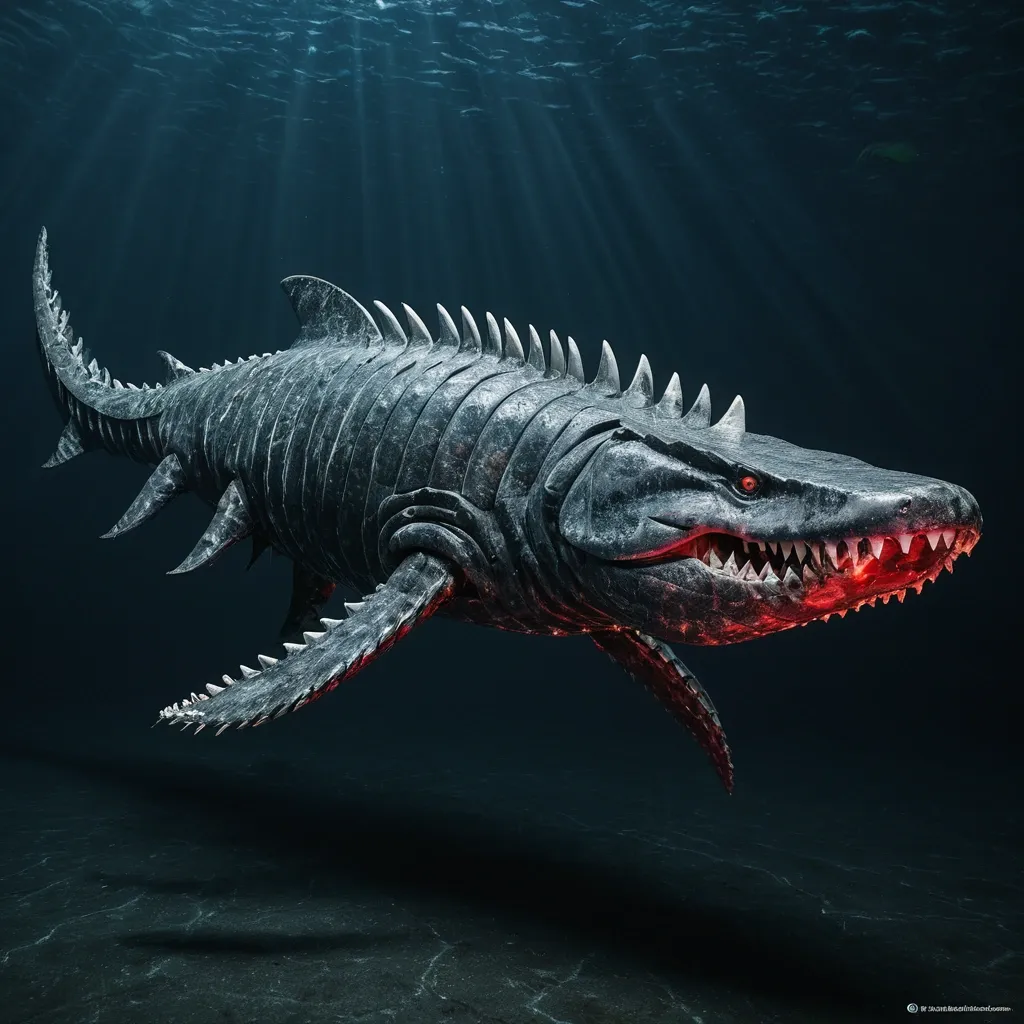
Female , Length: 40-60 feet , Weight: 50-75 tons , Lifespan: 100-135 years , Color is a slate gray base with white and red photophores arranged in tiger stripe patterns along the flanks and dorsal ridge , glowing vividly in abyssal darkness , a Robust , muscular frame combining the thick , armored scales of saltwater crocodile and arapaima with a hydrodynamic , flexible body of Mosasaurus Hoffmannii , Large , rigid pectoral fins capable of tilting backward to reduce drag , inspired by the Black Marlin’s speed adaptations , Powerful flippers adapted for both swimming and short-distance land movement , similar to a leopard seal’s scooting style , Enormous , reinforced jaws with over 40 , 000 PSI bite force , lined with long , razor-sharp canine teeth from Predator X and Megalodon genetics , Venomous spines inspired by the crown-of-thorns starfish line the dorsal ridge , delivering painful wounds to predators or rivals. ,
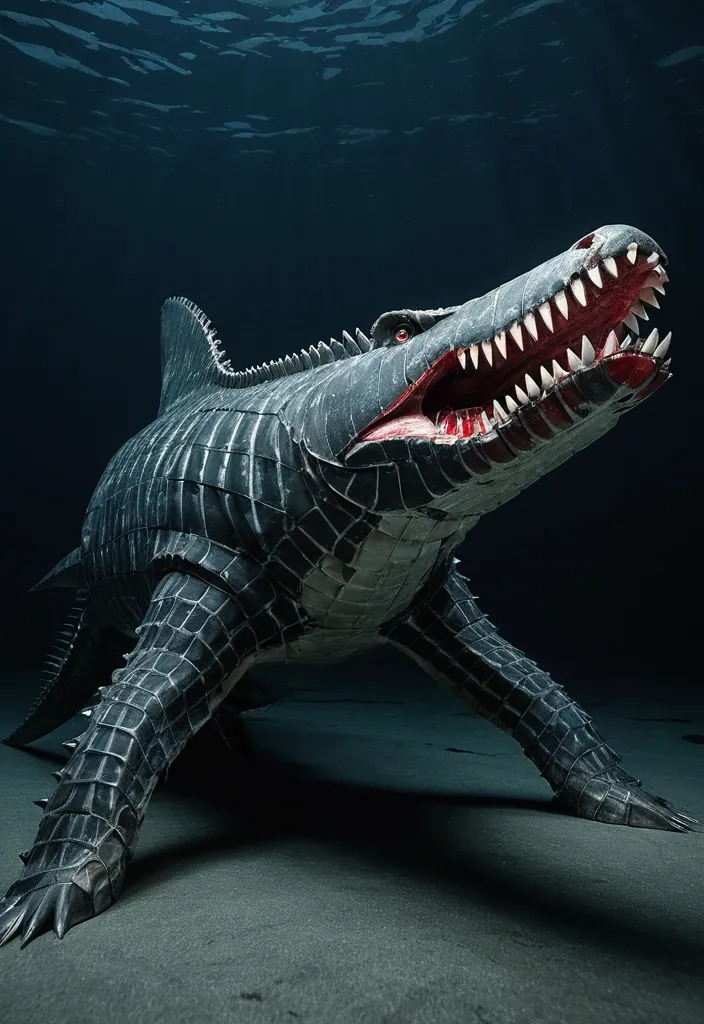
Female , Length: 40-60 feet , Weight: 50-75 tons , Lifespan: 100-135 years , Color is a slate gray base with white and red photophores arranged in tiger stripe patterns along the flanks and dorsal ridge , glowing vividly in abyssal darkness , a Robust , muscular frame combining the thick , armored scales of saltwater crocodile and arapaima with a hydrodynamic , flexible body of Mosasaurus Hoffmannii , Large , rigid pectoral fins capable of tilting backward to reduce drag , inspired by the Black Marlin’s speed adaptations , Powerful flippers adapted for both swimming and short-distance land movement , similar to a leopard seal’s scooting style , Enormous , reinforced jaws with over 40 , 000 PSI bite force , lined with long , razor-sharp canine teeth from Predator X and Megalodon genetics , Venomous spines inspired by the crown-of-thorns starfish line the dorsal ridge , delivering painful wounds to predators or rivals. ,
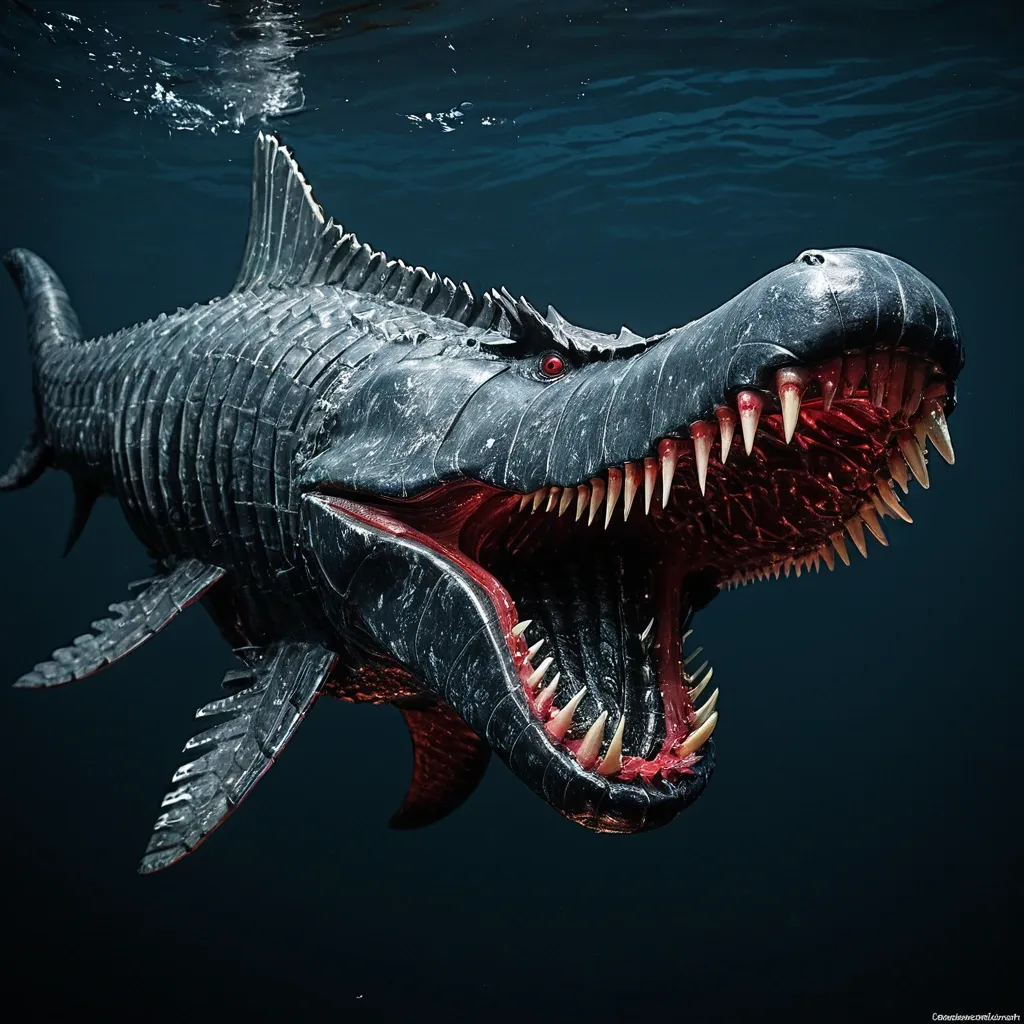
Males , Length: 40-60 feet , Weight: 50-75 tons , Lifespan: 100-135 years , Color is a Jet black base with red and light gray photophores arranged in a tiger stripe patterns along the flanks and dorsal ridge , glowing vividly in abyssal darkness , a streamlined , muscular frame combining the thick , armored scales of saltwater crocodile and arapaima with a hydrodynamic , flexible body of Mosasaurus Hoffmannii , Large , rigid pectoral fins capable of tilting backward to reduce drag , inspired by the Black Marlin’s speed adaptations , Powerful flippers adapted for both swimming and short-distance land movement , similar to a leopard seal’s scooting style , Enormous , reinforced jaws with over 40 , 000 PSI bite force , lined with long , razor-sharp canine teeth from Predator X and Megalodon genetics , Venomous spines inspired by the crown-of-thorns starfish line the dorsal ridge , delivering painful wounds to predators or rivals ,

Males , Length: 40-60 feet , Weight: 50-75 tons , Lifespan: 100-135 years , Color is a Jet black base with red and light gray photophores arranged in a tiger stripe patterns along the flanks and dorsal ridge , glowing vividly in abyssal darkness , a streamlined , muscular frame combining the thick , armored scales of saltwater crocodile and arapaima with a hydrodynamic , flexible body of Mosasaurus Hoffmannii , Large , rigid pectoral fins capable of tilting backward to reduce drag , inspired by the Black Marlin’s speed adaptations , Powerful flippers adapted for both swimming and short-distance land movement , similar to a leopard seal’s scooting style , Enormous , reinforced jaws with over 40 , 000 PSI bite force , lined with long , razor-sharp canine teeth from Predator X and Megalodon genetics , Venomous spines inspired by the crown-of-thorns starfish line the dorsal ridge , delivering painful wounds to predators or rivals ,

Males , Length: 40-60 feet , Weight: 50-75 tons , Lifespan: 100-135 years , Color is a Jet black base with red and light gray photophores arranged in a tiger stripe patterns along the flanks and dorsal ridge , glowing vividly in abyssal darkness , a streamlined , muscular frame combining the thick , armored scales of saltwater crocodile and arapaima with a hydrodynamic , flexible body of Mosasaurus Hoffmannii , Large , rigid pectoral fins capable of tilting backward to reduce drag , inspired by the Black Marlin’s speed adaptations , Powerful flippers adapted for both swimming and short-distance land movement , similar to a leopard seal’s scooting style , Enormous , reinforced jaws with over 40 , 000 PSI bite force , lined with long , razor-sharp canine teeth from Predator X and Megalodon genetics , Venomous spines inspired by the crown-of-thorns starfish line the dorsal ridge , delivering painful wounds to predators or rivals ,
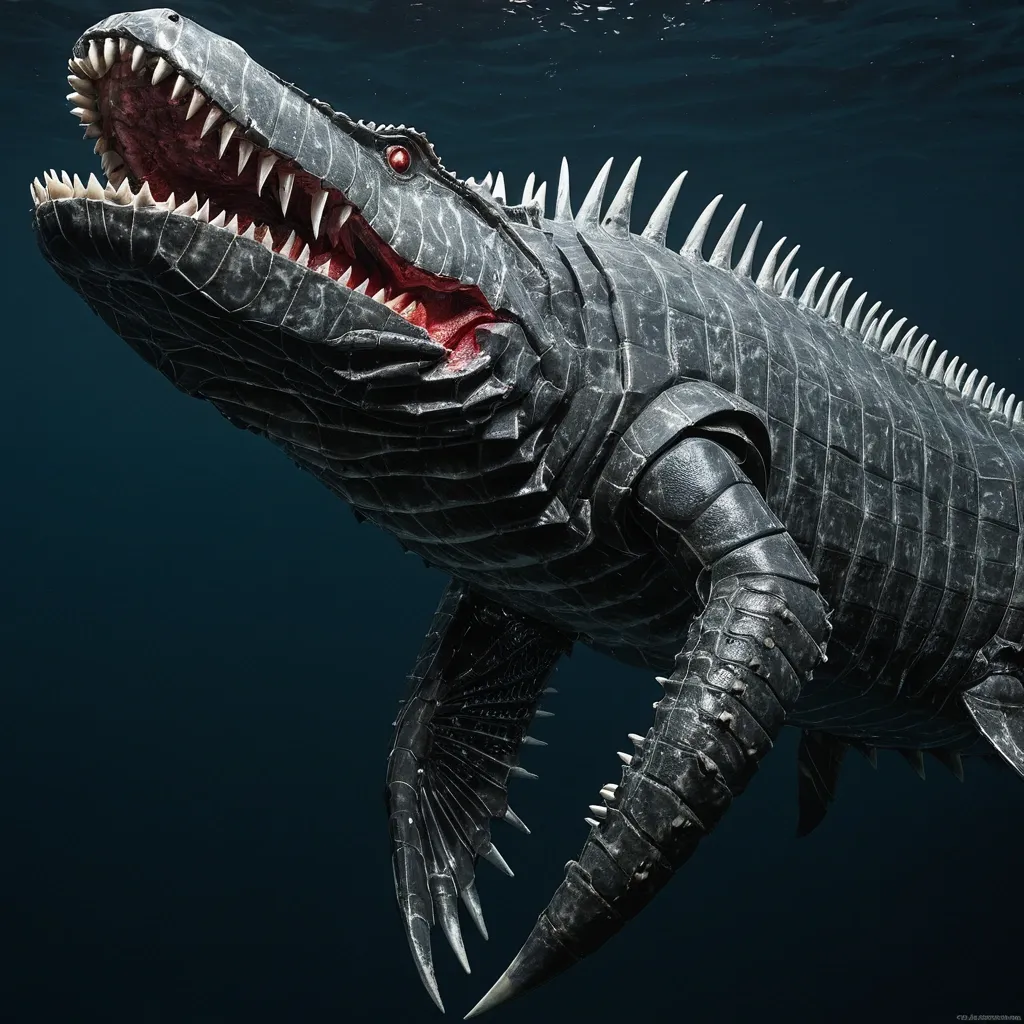
Female , Length: 40-60 feet , Weight: 50-75 tons , Lifespan: 100-135 years , Color is a slate gray base with white and red photophores arranged in tiger stripe patterns along the flanks and dorsal ridge , glowing vividly in abyssal darkness , a Robust , muscular frame combining the thick , armored scales of saltwater crocodile and arapaima with a hydrodynamic , flexible body of Mosasaurus Hoffmannii , Large , rigid pectoral fins capable of tilting backward to reduce drag , inspired by the Black Marlin’s speed adaptations , Powerful flippers adapted for both swimming and short-distance land movement , similar to a leopard seal’s scooting style , Enormous , reinforced jaws with over 40 , 000 PSI bite force , lined with long , razor-sharp canine teeth from Predator X and Megalodon genetics , Venomous spines inspired by the crown-of-thorns starfish line the dorsal ridge , delivering painful wounds to predators or rivals. ,
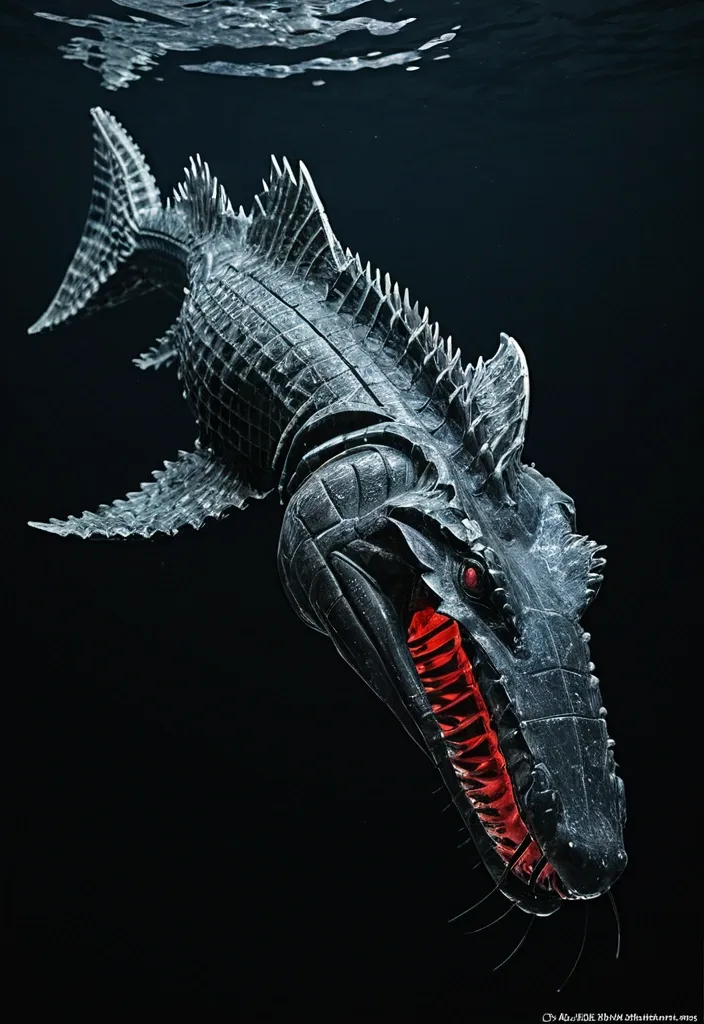
Males , Length: 40-60 feet , Weight: 50-75 tons , Lifespan: 100-135 years , Color is a Jet black base with red and light gray photophores arranged in a tiger stripe patterns along the flanks and dorsal ridge , glowing vividly in abyssal darkness , a streamlined , muscular frame combining the thick , armored scales of saltwater crocodile and arapaima with a hydrodynamic , flexible body of Mosasaurus Hoffmannii , Large , rigid pectoral fins capable of tilting backward to reduce drag , inspired by the Black Marlin’s speed adaptations , Powerful flippers adapted for both swimming and short-distance land movement , similar to a leopard seal’s scooting style , Enormous , reinforced jaws with over 40 , 000 PSI bite force , lined with long , razor-sharp canine teeth from Predator X and Megalodon genetics , Venomous spines inspired by the crown-of-thorns starfish line the dorsal ridge , delivering painful wounds to predators or rivals ,

Males , Length: 40-60 feet , Weight: 50-75 tons , Lifespan: 100-135 years , Color is a Jet black base with red and light gray photophores arranged in a tiger stripe patterns along the flanks and dorsal ridge , glowing vividly in abyssal darkness , a streamlined , muscular frame combining the thick , armored scales of saltwater crocodile and arapaima with a hydrodynamic , flexible body of Mosasaurus Hoffmannii , Large , rigid pectoral fins capable of tilting backward to reduce drag , inspired by the Black Marlin’s speed adaptations , Powerful flippers adapted for both swimming and short-distance land movement , similar to a leopard seal’s scooting style , Enormous , reinforced jaws with over 40 , 000 PSI bite force , lined with long , razor-sharp canine teeth from Predator X and Megalodon genetics , Venomous spines inspired by the crown-of-thorns starfish line the dorsal ridge , delivering painful wounds to predators or rivals ,

Males , Length: 40-60 feet , Weight: 50-75 tons , Lifespan: 100-135 years , Color is a Jet black base with Bioluminescent red and light gray photophores arranged in tiger stripe patterns along the flanks and dorsal ridge , glowing vividly in abyssal darkness , streamlined , muscular frame combining the thick , armored scales of saltwater crocodile and arapaima with a hydrodynamic , flexible body of Mosasaurus Hoffmannii , Large , rigid pectoral fins capable of tilting backward to reduce drag , inspired by the Black Marlin’s speed adaptations , Powerful flippers adapted for both swimming and short-distance land movement , similar to a leopard seal’s scooting style , Enormous , reinforced jaws with over 40 , 000 PSI bite force , lined with long , razor-sharp canine teeth from Predator X and Megalodon genetics , Venomous spines inspired by the crown-of-thorns starfish line the dorsal ridge , delivering painful wounds to predators or rivals ,

Males , Length: 40-60 feet , Weight: 50-75 tons , Lifespan: 100-135 years , Color is a Jet black base with Bioluminescent red and light gray photophores arranged in tiger stripe patterns along the flanks and dorsal ridge , glowing vividly in abyssal darkness , streamlined , muscular frame combining the thick , armored scales of saltwater crocodile and arapaima with a hydrodynamic , flexible body of Mosasaurus Hoffmannii , Large , rigid pectoral fins capable of tilting backward to reduce drag , inspired by the Black Marlin’s speed adaptations , Powerful flippers adapted for both swimming and short-distance land movement , similar to a leopard seal’s scooting style , Enormous , reinforced jaws with over 40 , 000 PSI bite force , lined with long , razor-sharp canine teeth from Predator X and Megalodon genetics , Venomous spines inspired by the crown-of-thorns starfish line the dorsal ridge , delivering painful wounds to predators or rivals ,
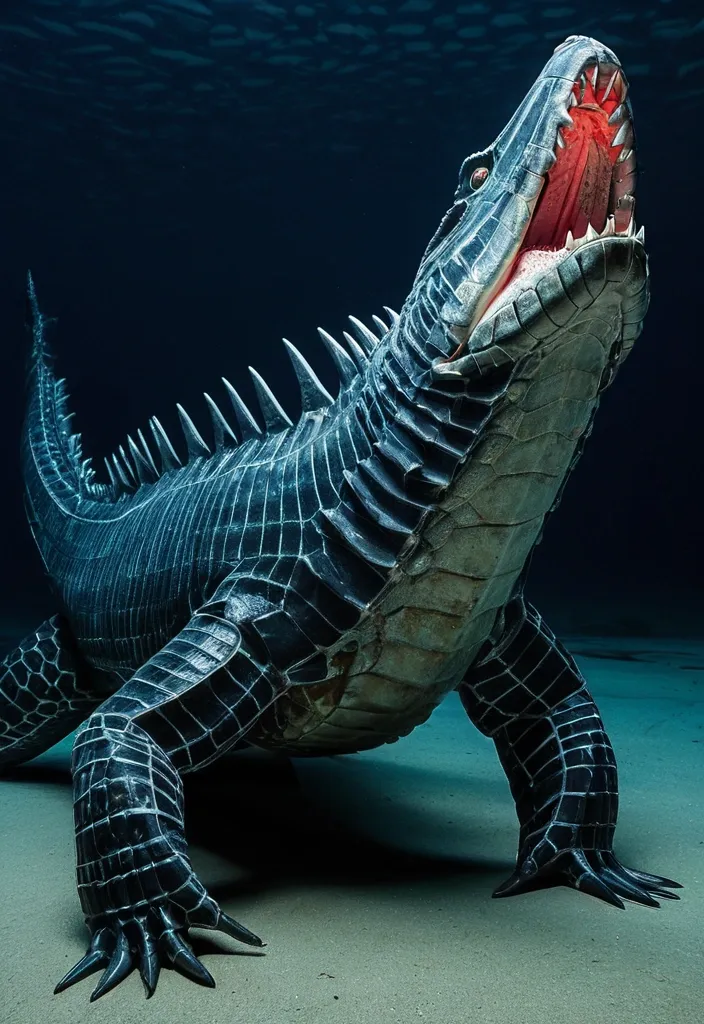
Males , Length: 40-60 feet , Weight: 50-75 tons , Lifespan: 100-135 years , Color is a Jet black base with Bioluminescent red and light gray photophores arranged in tiger stripe patterns along the flanks and dorsal ridge , glowing vividly in abyssal darkness , streamlined , muscular frame combining the thick , armored scales of saltwater crocodile and arapaima with a hydrodynamic , flexible body of Mosasaurus Hoffmannii , Large , rigid pectoral fins capable of tilting backward to reduce drag , inspired by the Black Marlin’s speed adaptations , Powerful flippers adapted for both swimming and short-distance land movement , similar to a leopard seal’s scooting style , Enormous , reinforced jaws with over 40 , 000 PSI bite force , lined with long , razor-sharp canine teeth from Predator X and Megalodon genetics , Venomous spines inspired by the crown-of-thorns starfish line the dorsal ridge , delivering painful wounds to predators or rivals ,

Males , Length: 40-60 feet , Weight: 50-75 tons , Lifespan: 100-135 years , Color is a Jet black base with Bioluminescent red and light gray photophores arranged in tiger stripe patterns along the flanks and dorsal ridge , glowing vividly in abyssal darkness , streamlined , muscular frame combining the thick , armored scales of saltwater crocodile and arapaima with a hydrodynamic , flexible body of Mosasaurus Hoffmannii , Large , rigid pectoral fins capable of tilting backward to reduce drag , inspired by the Black Marlin’s speed adaptations , Powerful flippers adapted for both swimming and short-distance land movement , similar to a leopard seal’s scooting style , Enormous , reinforced jaws with over 40 , 000 PSI bite force , lined with long , razor-sharp canine teeth from Predator X and Megalodon genetics , Venomous spines inspired by the crown-of-thorns starfish line the dorsal ridge , delivering painful wounds to predators or rivals ,
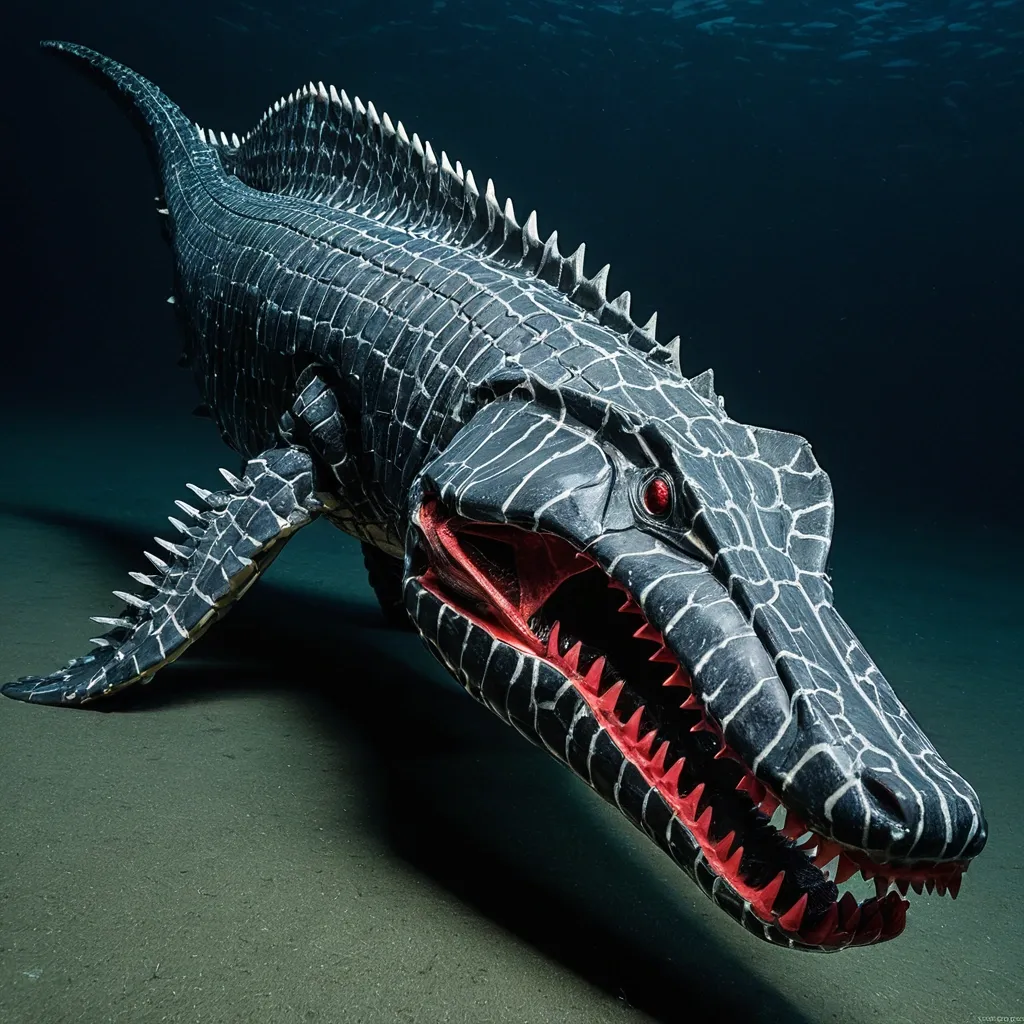
Males , Length: 40-60 feet , Weight: 50-75 tons , Lifespan: 100-135 years , Color is a Jet black base with Bioluminescent red and light gray photophores arranged in tiger stripe patterns along the flanks and dorsal ridge , glowing vividly in abyssal darkness , streamlined , muscular frame combining the thick , armored scales of saltwater crocodile and arapaima with a hydrodynamic , flexible body of Mosasaurus Hoffmannii , Large , rigid pectoral fins capable of tilting backward to reduce drag , inspired by the Black Marlin’s speed adaptations , Powerful flippers adapted for both swimming and short-distance land movement , similar to a leopard seal’s scooting style , Enormous , reinforced jaws with over 40 , 000 PSI bite force , lined with long , razor-sharp canine teeth from Predator X and Megalodon genetics , Venomous spines inspired by the crown-of-thorns starfish line the dorsal ridge , delivering painful wounds to predators or rivals ,

Males , Length: 40-60 feet , Weight: 50-75 tons , Lifespan: 100-135 years , Color is a Jet black base with Bioluminescent red and light gray photophores arranged in tiger stripe patterns along the flanks and dorsal ridge , glowing vividly in abyssal darkness , streamlined , muscular frame combining the thick , armored scales of saltwater crocodile and arapaima with a hydrodynamic , flexible body of Mosasaurus Hoffmannii , Large , rigid pectoral fins capable of tilting backward to reduce drag , inspired by the Black Marlin’s speed adaptations , Powerful flippers adapted for both swimming and short-distance land movement , similar to a leopard seal’s scooting style , Enormous , reinforced jaws with over 40 , 000 PSI bite force , lined with long , razor-sharp canine teeth from Predator X and Megalodon genetics , Venomous spines inspired by the crown-of-thorns starfish line the dorsal ridge , delivering painful wounds to predators or rivals ,

Female , Length: 40-60 feet , Weight: 50-75 tons , Lifespan: 100-135 years , Color is a slate gray base with Bioluminescent white and red photophores arranged in tiger stripe patterns along the flanks and dorsal ridge , glowing vividly in abyssal darkness , Robust , muscular frame combining the thick , armored scales of saltwater crocodile and arapaima with a hydrodynamic , flexible body of Mosasaurus Hoffmannii , Large , rigid pectoral fins capable of tilting backward to reduce drag , inspired by the Black Marlin’s speed adaptations , Powerful flippers adapted for both swimming and short-distance land movement , similar to a leopard seal’s scooting style , Enormous , reinforced jaws with over 40 , 000 PSI bite force , lined with long , razor-sharp canine teeth from Predator X and Megalodon genetics , Venomous spines inspired by the crown-of-thorns starfish line the dorsal ridge , delivering painful wounds to predators or rivals. ,






